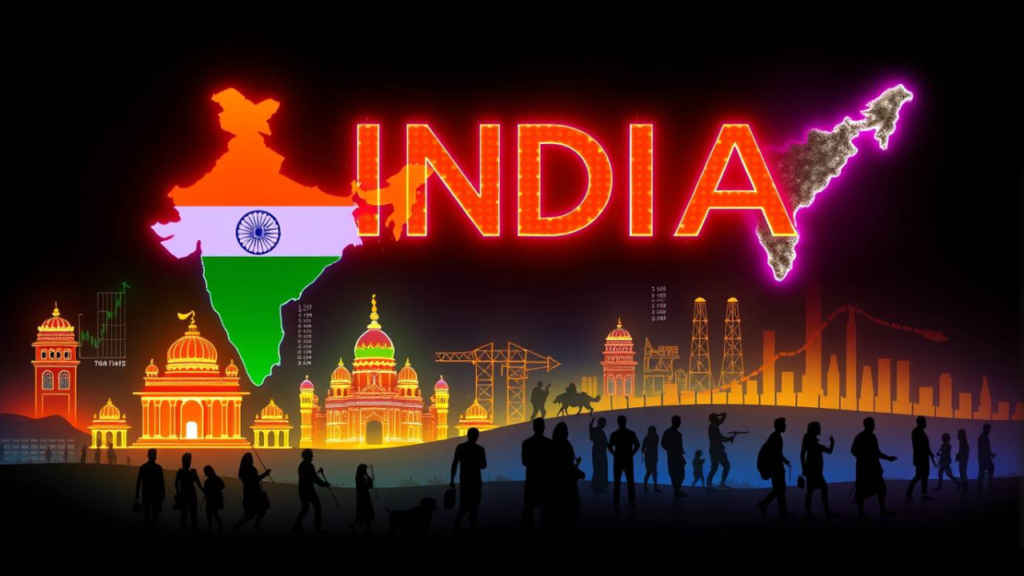This article explores India’s economic growth, cultural transformation, and the political shifts under Prime Minister Narendra Modi’s leadership.

India’s Growth, Hindu Nationalism, and Political Shifts
India stands as the fastest-growing major economy in the world, capturing the attention of global investors and emerging as a key player in geopolitics. With a burgeoning young population and favorable demographics, the country’s economic trajectory appears promising. However, this growth story is intertwined with profound cultural and political transformations driven by Prime Minister Narendra Modi, whose leadership has redefined the nation’s identity and governance.
Economic Growth and Global Standing
India’s economy is witnessing remarkable growth, with its GDP expanding at rates envied by most developed nations. A youthful workforce, rising consumer demand, and geopolitical realignments have positioned the country as a global powerhouse. International investors are optimistic about India’s potential, and Modi’s economic reforms, including tax restructuring and infrastructure development, have bolstered this confidence.
However, this prosperity has not reached all corners of the nation. Challenges such as unemployment, rural distress, and income inequality persist, especially among farmers and low-income groups. Despite these obstacles, Modi’s administration continues to project a narrative of economic optimism, resonating with urban voters and businesses.
Modi’s Vision: Hindu Nationalism in Governance
Narendra Modi’s tenure marks a departure from India’s secular political traditions. His vision integrates Hindu identity with governance, positioning India as a Hindu economic and cultural powerhouse. Central to this transformation is the emphasis on Hindu nationalism, a theme that dominates BJP policies and political strategies.
Modi’s initiatives, such as the construction of the Ram Temple in Ayodhya and the abrogation of Kashmir’s special status, reflect this ideological shift. Critics argue that these moves have polarized the nation, eroding its secular foundations and alienating minority communities. Nonetheless, these policies have solidified Modi’s base among Hindu voters, ensuring his dominance in electoral politics.
The Ram Temple: A Symbol of Identity and Power
The Ram Temple in Ayodhya stands as a potent symbol of Hindu nationalism and a cornerstone of Modi’s reelection strategy. The site, revered as the birthplace of the Hindu deity Ram, has a tumultuous history. The demolition of the Babri Masjid in 1992 sparked nationwide riots and marked a turning point in Indian politics.
Today, Ayodhya has transformed into a prominent pilgrimage destination, with the temple’s construction mobilizing Hindu voters across the country. For Modi, the temple signifies not just religious pride but also a triumph in aligning politics with cultural identity.
Opposition and Political Dynamics
The opposition, led by Rahul Gandhi’s Congress party, has struggled to challenge Modi’s electoral strength. Despite issues like inflation and unemployment, Modi’s credibility and ability to connect with voters remain unmatched. The BJP’s dominance in state and national elections reflects a political landscape increasingly inclined toward majoritarianism.
Cultural Polarization and Its Implications
India’s political shift from secularism to majoritarianism has polarized opinions. Proponents of Modi’s Hindu nationalist policies view them as a long-overdue assertion of cultural identity. Critics, however, warn of the risks of alienating minorities and deepening social divides.
Cultural polarization has also found expression in everyday life, with debates over language, religion, and history taking center stage. This transition has redefined what it means to be Indian, with implications that extend beyond politics into the nation’s cultural fabric.
Socioeconomic Inequality: An Unresolved Challenge
While urban India reaps the benefits of economic growth, rural regions continue to lag behind. Farmers, a significant demographic, face declining incomes and increasing debt. The government’s initiatives, though ambitious, have yet to address these disparities effectively.
Economic inequality poses a threat not just to India’s growth story but also to its social harmony. The question remains whether the nation’s leadership can balance economic ambitions with inclusive development.
Conclusion
India stands at a crossroads, navigating the interplay between economic aspirations and cultural nationalism. Under Modi’s leadership, the nation has experienced a significant political and cultural transformation, moving away from secularism toward a majoritarian identity. While this shift has consolidated support for the BJP, it has also deepened divisions within the country.
As India moves forward, the challenge lies in achieving equitable growth that uplifts all sections of society while preserving the diversity and secularism that have long been its defining characteristics.

